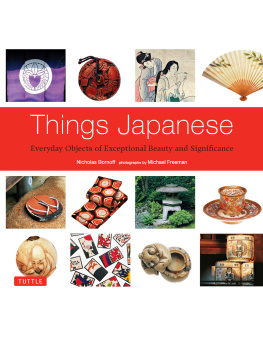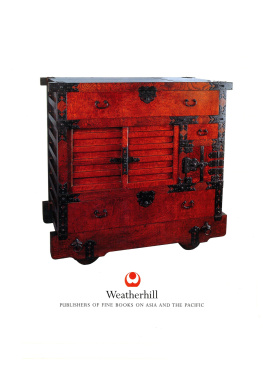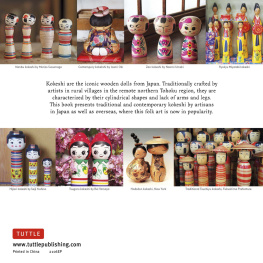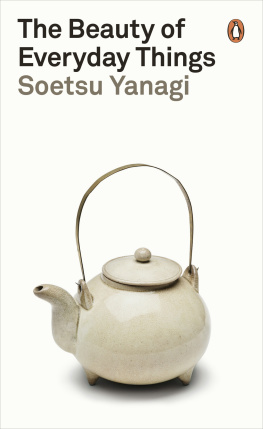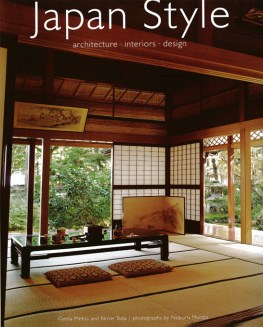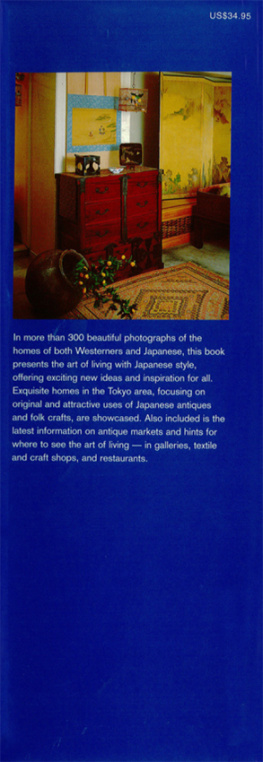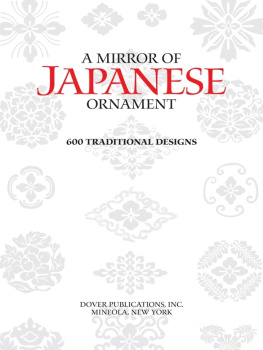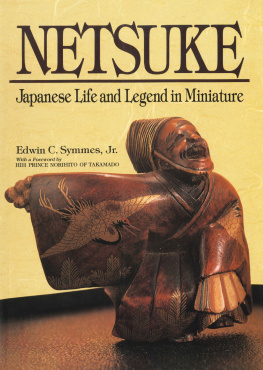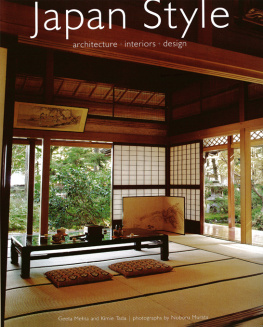
Bibliography
Akiyama, Terukazu, La Peinture Japonaise: Les Tresors de I'Asie, Editions Albert Skira, Geneve, 1978
Bowers, Faubion, Japanese Theatre, Charles E. Tuttle Co., Vermont, Tokyo, 1974
Bornoff, Nicholas, Pink Samurai - An Erotic Exploration of Japanese Society, Grafton, HarperCollins, London, 1991; National Geographic Traveler Series Guide to Japan, National Geographic
Bushell, Raymond, The Netsuke Handbook of Ueda Reikichi, Charles E. Tuttle Co., Vermont, Tokyo, 1961
DeBecker, J.E., The Nightless City - the History of the Yoshiwara Ykwaku, London, 1899 (Charles E. Tuttle Co., Vermont, Tokyo, 1971).
Dresser, Christopher, Japan: Its Architecture, Art and Art Manufacture, Longmans, Green & Co., London, 1882. (Reprinted as Traditional Arts and Crafts of Japan, Dover Publications Inc., New York, 1994)
Hibbett, Howard, The Floating World in Japanese Fiction, Oxford University Press, 1959 (Charles E. Tuttle Co., Vermont, Tokyo, 1975)
Kawabata, Yasunari, The Master of Go, Alfred A.Knopf, Inc., New York, 1972 (Charles E. Tuttle Co., Vermont, Tokyo, 1973)
Lane, Richard, Images from the Floating World - the Japanese Print, Office du Livre, Fribourg, Switzerland, 1978
Moes, Robert, Mingei, Japanese Folk Art from the Brooklyn Museum Collection, Universe Books, New York, 1985
Morris, Ivan, The World of the Shining Prince - Court Life in Ancient Japan, Alfred A. Knopf, Inc., New York, 1964 (Charles E. Tuttle Co., Vermont, Tokyo, 1978)
Morse, Edward, Japan Day by Day Vol. I, Houghton-Mifflin, 1915, 1945; Japan Day by Day Vol. II, Houghton-Mifflin, 1917, 1945 (Vols I and II, Cherokee Publishing Co., Atlanta, 1990); Japanese Homes and their Surroundings, Ticknor & Co., New York, 1886. (Dover Publications, Inc., New York, 1961)
Munsterberg, Hugo, The Japanese Print, John Weatherhill & Co., New York and Tokyo, 1982
Okakura, Kakuzo, The Book of Tea, Fox, Duffield & Co., New York, 1906 (Dover Publications Inc., New York, 1964)
Piggot, Juliet, Japanese Mythology, Hamlyn Publishing Group Ltd., London, 1969
Ponting, Herbert G., In Lotus Land Japan, MacMillan & Co., London, 1910.
Saito, Akio (editor), A Look Into Japan, Japan Travel Bureau, Inc., 1984; Japan, the Official Guide, Japan Travel Bureau Inc., 1952
Stevenson, John (with introduction by Donald Richie), Yoshitoshi's Thirty-Six Ghosts, Weatherhill, New York and Tokyo/Blue Tiger, Hong Kong, 1983
Tagai, Hideo, Japanese Ceramics, Hoikusha, Osaka, Japan 1976
Watson, William (editor), The Great Japan Exhibition: Art of the Edo Period, Royal Academy of Arts London, 1981-82
Watt, Andrew, The Truth About Japan!, Yen Books, Charles E. Tuttle Co., Vermont, Tokyo, 1988
Internet sources:
Maneki Neko, Alan Pate; L'Asie Exotique of La Jolla California, 1996. Antique Japanese Festival Dolls, T. Mertel; L'Asie Exotique, 1986. The Practice of Using Seals, William Lise; Japan Chopsticks and Wood, TED Studies.
Karuta, Sports or Culture? David Bull, 1996 (from Hyakunin Issho, internet newsletter by print artist David Bull). What is Hyotan? Article in Hyotan Newspaper, Hitachi, Japan. (Futon) Japan Trade Monthly Kimono Fujikawa web site.
Contents
Published by Tuttle Publishing, an imprint of Periplus Editions (HK) Ltd.
www.tuttlepublishing.com
Copyright 2002 Periplus Editions (HK) Ltd
Text 2002 Nicholas Bornoff
Photos 2002 Michael Freeman
This paperback edition 2013 Periplus Editions (HK) Ltd
All rights reserved. No part of this publication may be reproduced or utilized in any form or by any means, electronic or mechanical, including photocopying, recording, or by any information storage and retrieval system, without prior written permission from the publisher.
ISBN: 978-1-4629-1381-7 (ebook)
Distributed by
North America, Latin America & Europe
Tuttle Publishing
364 Innovation Drive
North Clarendon
VT 05759-9436 U.S.A.
Tel: 1 (802) 773-8930
Fax: 1 (802) 773-6993
www.tuttlepublishing.com
Japan
Tuttle Publishing
Yaekari Building, 3rd Floor
5-4-12 Osaki
Shinagawa-ku, Tokyo 141-0032
Tel: (81) 3 5437-0171
Fax: (81) 3 5437-0755
sales@tuttle.co.jp
www.tuttle.co.jp
Asia Pacific
Berkeley Books Pte. Ltd.
61 Tai Seng Avenue, #02-12
Singapore 534167
Tel: (65) 6280-1330
Fax: (65) 6280-6290
inquiries@periplus.com.sg
www.periplus.com
16 15 14 13
8 7 6 5 4 3 2
Printed in Singapore 1312TW
TUTTLE PUBLISHING is a registered trademark of Tuttle Publishing, a division of Periplus Editions (HK) Ltd.


Credits
With special thanks to:
Masami, for her encouragement and
support; Monique Calahan; Leslie
Downer; Michiko Rico Nos; Mrs
Kimura, Casa Kimura, Kokubunji;
Madoka Shiraishi; Tawaraya Inn,
Kyoto.
The Japanese Gallery
660 Kensington Church Street
London W8 4BY, UK
tel/fax: +44 20 7229 2934
23 Camden Passage, London N1 8EA
tel: +44 20 7226 3347
1-5-1, Fukushima-cho
Nishi-ku, Hiroshima City, Japan 733
tel: +81 82 231 6066
Katie Jones
195 Westbourne Grove,
London W11 2SB, UK
tel: +44 20 7243 5600
fax: +44 20 7243 4653
e-mail: kjoriental@lineone.net
Gregg Baker
132 Kensington Church Street,
London W8 4BH, UK
tel: +44 20 7221 3533
fax: +44 20 7221 4410
e-mail gbakerart@aol.com
Foreword
Outside Japan, the words 'things Japanese' often conjure concepts which the Japanese themselves would greet, at best, with indulgent smiles. Netsuke, inr, iron kettles, swords and so onall items that began to go out of fashion when Japan started to open its doors to the outside world following the Meiji restoration of 1868. You could add things like tea ceremony ceramics, paintings on sliding screen doors, tatami mats, stone lanterns and kimono to the listeven though these are alive and well. Some Japanese construe these attributes as grossly antiquated stereotypes, and are likely to resent it when foreigners acclaim them. "Kimono! Geisha! Fuji-yama", they fume, despite the fact that they all not only still exist, but are also exalted by many Japanese (who still wear kimono on special occasions) themselves. They may scoff at 'Fuji-yama' (the Japanese have never called their most famous mountain anything but 'Fuji-san') but, oh, how often one sees travel posters of Mt Fuji with girls in kimonooften holding paper umbrellas for good measuredeployed in the corridors of train stations!
The cutting edge of high technology is undeniably more the stuff of modern Japan than the samurai sword, but several venerable swordsmiths designated 'Living National Treasures' still forge the world's finest blades, just as they did centuries ago. Although obviously diminished, the proliferation of traditional arts and crafts in modern Japan is astonishing. With the introduction of the three-piece suit in the 1870s, inr (the little tiered medicine boxes hanging from the kimono belt) may have gone the way of netsuke (the amazing miniature sculptures used to toggle them) but the skills of the craftsmen making them remain very much alive, albeit for different applications. Workshops in Kanazawa and Kyoto still make exquisite painted, embroidered or tie-dyed silk textiles; craftsmen all over Honshu and Kyushu continue to produce outstanding ceramics. Japanese lacquerware finds few rivals worldwide; many modern Japanese, whether serious calligraphers or just for writing seasonal greetings, keep a lacquer writing box complete with brushes and ink-stone. Notwithstanding the ferro-concrete urban sprawl, the wooden Japanese house still existsin many cases just as an interior in a high rise apartment. Some people continue to paint traditional screen doors and, during the summer months especially, everyone likes to sprawl on the cool, comfortable smoothness of the tatami floor.
Next page
